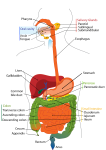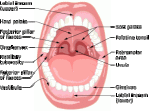
The pancreas is a glandular organ in the upper abdomen, but really it serves as two glands in one: a digestive exocrine gland and a hormone-producing endocrine gland. Functioning as an exocrine gland, the pancreas excretes enzymes to break down the proteins, lipids, carbohydrates, and nucleic acids in food. Functioning as an endocrine gland, the pancreas secretes the hormones insulin and glucagon to control blood sugar levels throughout the day. Both of these diverse functions are vital to the body’s survival.
Anatomy of the pancreas
Gross Anatomy
The pancreas is a narrow, 6-inch long gland that lies posterior and inferior to the stomach on the left side of the abdominal cavity. The pancreas extends laterally and superiorly across the abdomen from the curve of the duodenum to the spleen. The head of the pancreas, which connects to the duodenum, is the widest and most medial region of the organ. Extending laterally toward the left, the pancreas narrows slightly to form the body of the pancreas. The tail of the pancreas extends from the body as a narrow, tapered region on the left side of the abdominal cavity near the spleen.
Glandular tissue that makes up the pancreas gives it a loose, lumpy structure. The glandular tissue surrounds many small ducts that drain into the central pancreatic duct. The pancreatic duct carries the digestive enzymes produced by endocrine cells to the duodenum.
Microscopic Anatomy
The pancreas is classified as a heterocrine gland because it contains both endocrine and exocrine glandular tissue. The exocrine tissue makes up about 99% of the pancreas by weight while endocrine tissue makes up the other 1%. The endocrine tissue is arranged into many small masses known as acini. Acini are small raspberry-like clusters of exocrine cells that surround tiny ducts. The exocrine cells in the acini produce digestive enzymes that are secreted from the cells and enter the ducts. The ducts of many acini connect to form larger and larger ducts until the products of many acini run into the large pancreatic duct.
The endocrine portion of the pancreas is made of small bundles of cells called islets of Langerhans. Many capillaries run through each islet to carry hormones to the rest of the body. There are 2 main types of endocrine cells that make up the islets: alpha cells and beta cells. Alpha cells produce the hormone glucagon, which raises blood glucose levels. Beta cells produce the hormone insulin, which lowers blood glucose levels.










